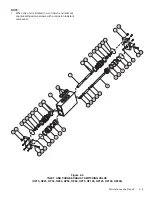
2 - 6
Installation
2.10
Instrumentation
The following instrumentation helps in monitoring dryer
operation and performance. Instruments which are avail-
able as options are so noted.
Power ON Light
The power ON light on the control panel indicates when the
dryer is turned on and operating.
Chamber Pressure Gauges
A gauge mounted on the inlet valve block (models OP15
through OP300) or panel mounted (models OP400 and
OP500) indicates which chamber is on-stream and which
is regenerating. The gauge for the on-stream chamber
indicates operating pressure; the gauge for the regenerat-
ing chamber should indicate 0 psig.
Purge Flow Indicator
A locally mounted gauge indicates purge air pressure as
an approximate measure of purge air flow when used with
a calibration graph from Appendix A.
To calculate purge flow consumption on the critical orifice
curve.
Inlet Flow (SCFM) × 14.7 PSIG
× 1.15 = Purge (SCFM)
Inlet Pressure (PSIG) + 14.7 PSIG
Cross the Purge Flow requirement calculated above to the
same number on the Critical Orifice Calibration Curve.
Follow this line vertically and then horizontally once inter-
section is made with the curve line to find the actual purge
pressure setting.
Moisture Indicator (optional)
An indicator utilizing specially treated "silica gel" which
changes color to alert personnel of a moisture problem re-
quiring corrective action. The indicator is blue when dry,
but gradually changes to pink in color whenever a "wet
gas" sample is received.
Valve Switching Failure (optional)
This alarm is triggered when the drying chambers are not
in the correct pressure state. The chamber pressure
switch should be open on the on-stream chamber and
closed on the regenerating chamber. If triggered, the dryer
control system will energize the red LED on the control
panel labeled VALVE FAILURE and de-energize the com-
mon alarm relay. The alarm automatically clears once the
alarm conditions are corrected.
Optitek 2 EMS Energy Management System (optional)
The optional Optitek 2 EMS energy management system
automatically adjusts dryer operation to compensate for
changes in operating conditions. Air samples are periodi-
cally taken from within each vessel and passed over a ca-
pacitance probe which senses both temperature and rela-
tive humidity. The dew point of the air within the desiccant
bed is then precisely determined. While the dryer contin-
ues to operate on a fixed drying cycle, the regeneration
cycle will not be initiated until a predetermined set point has
been reached. Purge air consumption is reduced to a
minimum.













































